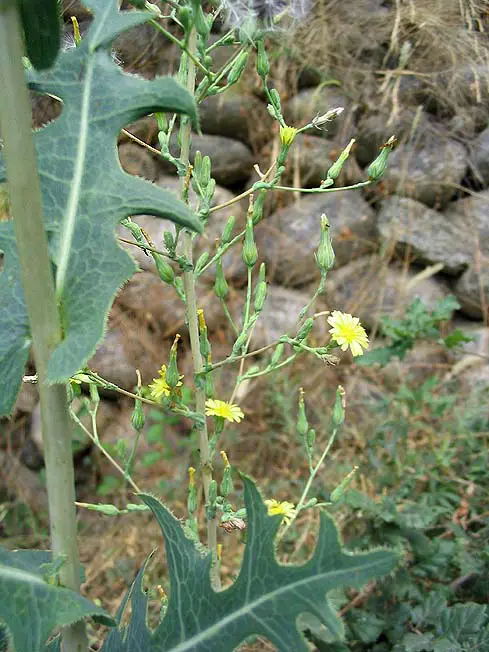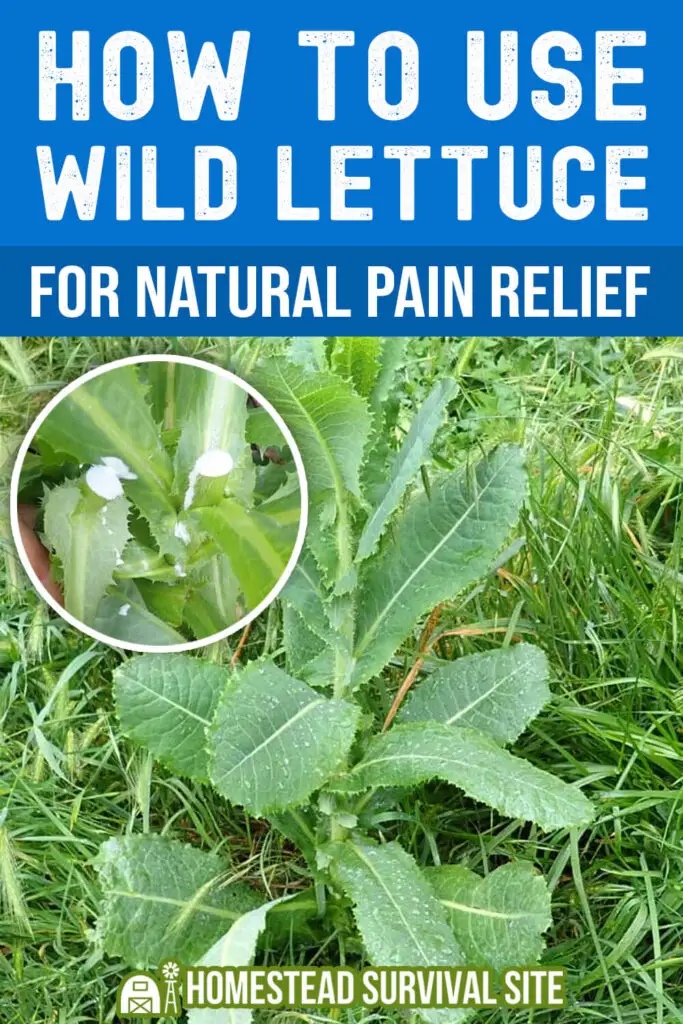Estimated reading time: 6 minutes
Growing plants for food and medicinal purposes is an important part of adopting a more self-sufficient lifestyle. If you want to take it to the next level, you should start learning about wild plants and how they can help nourish and heal us.
For centuries, herbalists and natural health practitioners have used certain wild lettuces, part of the genus Lactuca, as a natural pain reliever. This article explains how to find and identify wild lettuce and how to use it as an analgesic.
What is Wild Lettuce?
Wild lettuce is a term used to describe a large group of weeds that look like a cross between lettuce and dandelions. Native to Europe, Asia, and Northern Africa, these weeds are biennials. Some varieties can reach a height of up to six feet.
Some wild lettuce plants are edible and can be eaten in salads and side dishes, while others are very bitter-tasting and could be toxic when consumed.
However, the plants also contain a milky white substance – known as lactucarium – inside their leaves and stems that may offer beneficial effects.
Want to save this post for later? Click Here to Pin It On Pinterest!

There are at least 50 species in the genus Lactuca, which we broadly call wild lettuce, and the plants grow on every continent other than Antarctica.
The plant is highly adaptable to different surroundings, but it's typically found in sunny locations along roadsides, forest edges, streams, and riverbanks. Wild lettuce does not thrive in dense, forested areas that get little sunlight or in areas with standing water, like bogs, or other wetlands.
Wild lettuce has bright green leaves that sprout from a green stem that may be covered with purple spots. This video shows how to distinguish between wild lettuce and dandelions.
One of the main distinguishing factors of wild lettuce compared with dandelions is the appearance of tiny hairs along the underside of the midrib. Dandelions do not have these hairs.
Another difference between the two commonly confused plants is the shape of the midrib. If you look at a cross-section of a wild lettuce rib, you will see a triangular shape. On the other hand, a dandelion has a round or oval-shaped cross-section.
Wild lettuce features a basal rosette in its first year and a tall stalk in its second year. Its leaves, which can vary significantly in shape depending on the species, typically appear on the stalk in an alternate pattern. Some wild lettuce species display yellow flowers.

Check out this video for more information on positively identifying wild lettuce.
What Are The Health Benefits of Wild Lettuce?
Through the centuries, herbalists have compared the pain-relieving and anti-inflammatory effects of the substance found in wild lettuce to those of opium, except with fewer side effects.
In the 19th and early 20th centuries, lactucarium from wild lettuce was often used as a sedative, diuretic, and analgesic. In its 1917 catalog of medicinal plants, the Servall Company claimed that wild lettuce was “highly esteemed to quiet coughing and allay nervous irritation, a good safe remedy to produce sleep, to be used when opium and other narcotics are objectionable.”
Although few modern scientific studies back up these anecdotal claims, wild lettuce continues to be used throughout the world for pain relief. Many homeopathic products that contain extracts of wild lettuce seeds, leaves, and sap are marketed to treat the following conditions.
- joint pain
- menstrual cramps
- poor sleep
- arthritis
- anxiety
- breathing issues
- insomnia
- urinary infections
Before consuming wild lettuce or using it for medical purposes, it is important to consult your health professional.
This article from the Northeast School of Botanical Medicine describes how to make a concentrated pain-relieving and sleep-inducing tincture from wild lettuce. Here are the instructions for the multiple-day process.
Day 1
- Gather wild lettuce plants.
- Cut up the plants and place them in the blender.
- Blend the cut-up with 95% ethanol in a 1:2 ratio.
- Pour the mixture into a separate container and let it sit for a minimum of 48 hours.
Day 3
- Use a tincture press to press out the liquid.
- Clean the container and pour the liquid back in.
- Gather more fresh wild lettuce plants and repeat the Day 1 steps.
- With a 1:2 ratio, prepare and pour a mixture of half 95% ethanol and half of the tincture from Day 1.
Day 4
- Press out the tincture made on Day 2
- Gather more wild lettuce and follow the Day 3 steps.
- Let the mixture sit for a minimum of two weeks.
After 2 weeks
- Press out the tinctures from Days 3 and 4 to complete the process.
This video demonstrates how to make a shelf-stable concentrated wild lettuce extract. And here is another helpful video demonstration. Both videos also show how to harvest the wild lettuce. As with many plants, the best time to harvest wild lettuce is at the time of flowering.
Here is another video that shows you the process of making wild lettuce extract at home.
Other Medicinal Options for Wild Lettuce
In addition to making a tincture, you can make a healing tea from dried wild lettuce leaves or dried wild lettuce flowers.
Watch this video to learn how to make wild lettuce flower tea. And this video demonstrates how to use dried wild lettuce leaves to make tea. Generally, you can use one to two tablespoons of dried leaves per cup of boiling water.
Since preparations and concentrations can vary widely, there is no consensus on dosages for using wild lettuce tincture as a pain reliever. However, 12–24 drops two or three times a day are suggested in this resource — Biologically Active Preparations From Lactuca Virosa L. Once again, it is important to check with your doctor before using this or any other supplement. Also, wild lettuce is not appropriate for anyone with a latex allergy.
If you'd prefer not to forage your own wild lettuce, you can find wild lettuce preparations online and in health food retailers in dried form, liquid extracts, capsules, and powders. Look for brands that have been certified by a third-party organization, such as USP, NSF, or Consumer Lab.
For more information on wild lettuce, here are a few more resources to consider.
- Eat the Weeds: A Forager’s Guide by Deane Jordan
- The New Foraging Bible for Beginners by Andrew Kennest
- Forager's Harvest 101 by Diane Wells
Like this post? Don't Forget to Pin It On Pinterest!
You May Also Like:











